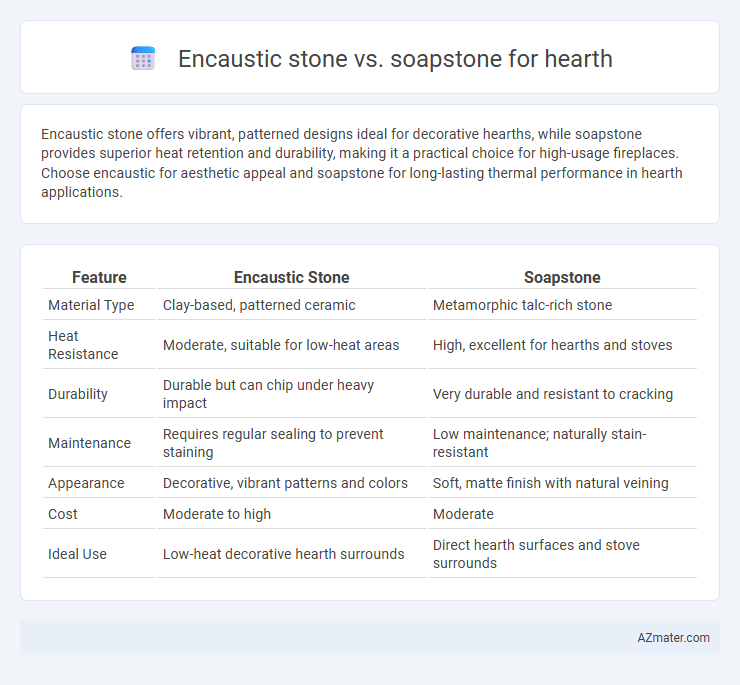Encaustic stone offers vibrant, patterned designs ideal for decorative hearths, while soapstone provides superior heat retention and durability, making it a practical choice for high-usage fireplaces. Choose encaustic for aesthetic appeal and soapstone for long-lasting thermal performance in hearth applications.
Table of Comparison
| Feature | Encaustic Stone | Soapstone |
|---|---|---|
| Material Type | Clay-based, patterned ceramic | Metamorphic talc-rich stone |
| Heat Resistance | Moderate, suitable for low-heat areas | High, excellent for hearths and stoves |
| Durability | Durable but can chip under heavy impact | Very durable and resistant to cracking |
| Maintenance | Requires regular sealing to prevent staining | Low maintenance; naturally stain-resistant |
| Appearance | Decorative, vibrant patterns and colors | Soft, matte finish with natural veining |
| Cost | Moderate to high | Moderate |
| Ideal Use | Low-heat decorative hearth surrounds | Direct hearth surfaces and stove surrounds |
Introduction to Encaustic Stone and Soapstone Hearths
Encaustic stone hearths feature patterned, baked clay tiles known for their vibrant colors and intricate designs, offering a decorative yet durable surface ideal for traditional and contemporary hearths. Soapstone hearths, composed of dense metamorphic rock rich in talc, provide exceptional heat retention and a smooth, natural finish that ages gracefully over time. Both materials offer unique aesthetic and functional benefits, with encaustic tiles emphasizing ornamental appeal and soapstone delivering superior thermal performance.
Material Composition and Properties
Encaustic stone hearths feature a unique composition of fired clay and natural pigments, offering vibrant, long-lasting color with a hard, durable surface ideal for heat resistance. Soapstone hearths consist primarily of talc, magnesium, and chlorite minerals, providing excellent heat retention and a naturally smooth texture that resists cracking under thermal stress. Both materials exhibit high thermal stability, but encaustic stone emphasizes decorative appeal while soapstone prioritizes functional heat endurance.
Heat Resistance and Thermal Retention
Encaustic stone offers moderate heat resistance but excels in aesthetic appeal, making it suitable for decorative hearth surfaces with lower direct heat exposure. Soapstone provides superior heat resistance and exceptional thermal retention, allowing it to absorb and radiate heat evenly over time, ideal for efficient hearth applications. Its dense, non-porous structure ensures durability and consistent warmth, outperforming encaustic stone in functional heat management.
Aesthetic Appeal and Design Versatility
Encaustic stone offers vibrant, patterned surfaces with rich colors and intricate designs, making it ideal for creating bold, artistic hearths that serve as focal points in interior spaces. Soapstone provides a more subdued, natural appearance with smooth textures and soft, earthy tones, lending itself to rustic or minimalist hearth designs that emphasize warmth and simplicity. Both materials offer unique aesthetic appeal and design versatility, but encaustic stone excels in decorative variety while soapstone stands out for timeless elegance and durability.
Durability and Longevity
Encaustic stone offers strong durability and maintains its vibrant patterns over time, making it ideal for decorative hearths that require both toughness and aesthetic appeal. Soapstone is highly durable and heat-resistant, with the unique ability to absorb and slowly radiate heat, enhancing hearth efficiency and longevity under heavy use. Both materials resist cracking and staining, but soapstone's natural density and hardness lend superior long-term performance in high-temperature hearth environments.
Maintenance and Cleaning Requirements
Encaustic stone hearths require regular sealing and gentle cleaning with pH-neutral products to prevent staining and preserve their vibrant patterns. Soapstone hearths offer low maintenance benefits, as their dense, non-porous surface resists heat and stains naturally, needing only occasional wiping with mild soap and water. Both materials benefit from avoiding abrasive cleaners to maintain their appearance and structural integrity over time.
Cost Comparison and Budget Considerations
Encaustic stone typically carries a higher price due to its intricate patterns and artisanal production, making it a more premium option for hearths compared to soapstone. Soapstone offers a more budget-friendly alternative with its natural durability and heat resistance, often costing 20-40% less than encaustic stone per square foot. When budgeting for a hearth project, factoring in encaustic stone's installation complexity and potential maintenance costs is essential, as soapstone generally requires less upkeep and simpler installation, reducing overall expense.
Environmental Impact and Sustainability
Encaustic stone, often made from natural clay and mineral pigments, is a more sustainable option due to its low-energy manufacturing process and biodegradability compared to soapstone, which involves intensive quarrying and has a higher carbon footprint. Soapstone, while durable and heat-resistant, requires significant extraction efforts that contribute to habitat disruption and increased emissions. Choosing encaustic stone for a hearth promotes reduced environmental impact through eco-friendly materials and lower embodied energy.
Installation Process and Challenges
Encaustic stone hearths require precise adhesion techniques due to their porous and decorative surface, often necessitating specialized mortar and sealing to prevent moisture damage during installation. Soapstone hearths offer easier installation as their dense, non-porous nature allows for straightforward cutting and fitting, but require careful handling to avoid chipping or cracking. Both materials demand skilled labor; however, encaustic stone poses more challenges with moisture sensitivity and alignment, while soapstone requires attention to weight support and surface finishing.
Choosing the Right Stone for Your Hearth
Encaustic stone offers intricate patterns and vibrant colors, making it an ideal choice for decorative hearths that emphasize aesthetic appeal, while soapstone provides excellent heat retention and durability for functional hearths subject to frequent use. Soapstone's natural resistance to heat and its ability to absorb and slowly release warmth enhances fireplace efficiency, whereas encaustic stone requires proper sealing to prevent staining and heat damage. Selecting between encaustic and soapstone hinges on the desired balance between ornamental design and practical heat management for your hearth.

Infographic: Encaustic stone vs Soapstone stone for Hearth
 azmater.com
azmater.com